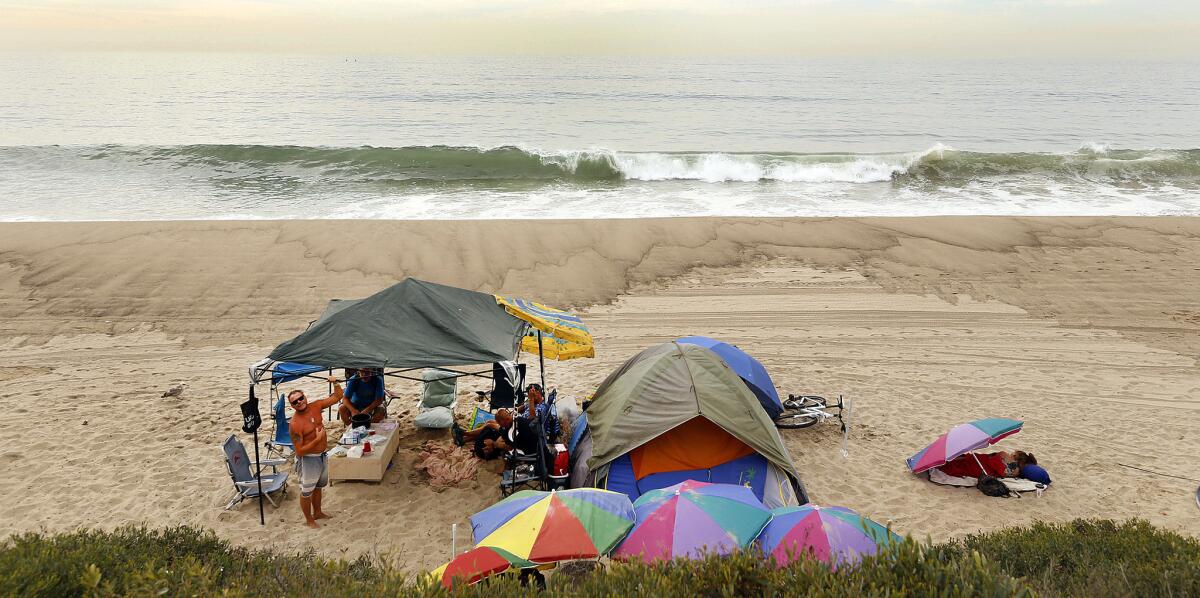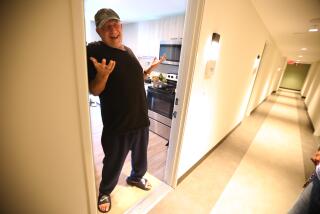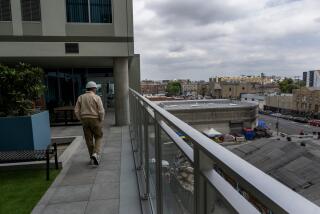Column: The mystery homeless woman of Pacific Palisades and the village that helped her home

Voluntarios y policías ayudan a rescatar a una mujer con enfermedades mentales de los acantilados de Pacific Palisades.
She became a fixture in Pacific Palisades, strolling aimlessly through the village for hours each day, a visible yet distant presence in the affluent seaside community.
No one could talk to her. She made snorting sounds at anyone who tried. She punched at the air, contorted her body and remained sealed in her cocoon, eyes hidden behind dark shades.
Some locals referred to her as Pretty Blonde.
When you think of homelessness in Los Angeles, skid row comes to mind along with Venice and Santa Monica, among other places. But the Palisades has its own issue.At one point not long ago, 200 homeless people lived in and around town. Nearly all of them have had some degree of mental illness, says LAPD officer Rusty Redican, who works the homeless beat in the Palisades area. At one time, 15-20 of them camped in dense brush on the bluffs overlooking the beach — million-dollar views for people with nothing but the clothes on their backs.
A couple of years ago, local residents formed the Pacific Palisades Task Force on Homelessness. The goal, said Doug McCormick, one of the founders, was not to push people into neighboring communities. It was to link up with professional outreach workers and the police, and offer treatment and shelter to those in need.

The ‘Pretty Blonde’ of Pacific Palisades
Nancy Klopper, a Hollywood casting director whose dozens of credits include “Ray,” “Fantastic Four” and “Devil’s Advocate,” joined the cause early on, and she became particularly concerned about the woman who took daily walks through the village.
“She was so clearly ill,” says Klopper, who, with a trained eye, noticed that the woman’s facial bone structure made her look foreign, and possibly northern European. “Every day I would look at her and I would think, ‘She’s somebody’s daughter. Somewhere there’s a mother looking for her.’ ”
Not that the woman was the only homeless person withering away in the Palisades.
“When you can see and watch their physical decline, and you see them getting worse and it’s out of your control because they’re so resistant to help, it’s painful to watch,” said Klopper.
And yet Klopper and others have proved that helping people, even if they’re resistant at first, is not impossible.
When the village visitor known as Pretty Blonde was not wandering the streets, she was seen on the bluff between the village and the beach, living in one of two campsites. The slope is steep, and you have to be something of a trailblazer to carve your way through thick, thorny brush to make it to those sites. Officer Redican, who led me to those sites, said coyotes, snakes, and human predators make the area particularly dangerous, as does the high fire risk.
The woman was more obviously ill than others, said Redican, and he wanted to try to convince her to get help. But when he spotted her from the top of the bluff, she squirted out of her campsite and down to the PCH. When he approached from the bottom of the bluff, she scampered up the slope and out of sight.
‘Can I go now?’
The times he and his LAPD partner Jimmy Solimon did track her down, she flailed, panicked and resisted help. But Redican found an approach that sometimes worked.
“If I talked real low, she’d listen,” he said. Still, she routinely resisted offers of housing or treatment and would insist, “Can I go now?”
Redican didn’t give up on her. Through her illness, he said, “There was a part of her that was lucid enough to know we were trying to help.” But she would not voluntarily accept that help, and forced hospitalization requires a mental health evaluation team to determine that a person is gravely disabled, or unable to provide for basic needs such as food, clothing or shelter.
It’s a tough standard to meet, and people are literally dying because of it. As I’ve written before, thanks to a number of advocates, a movement is under way in Los Angeles to reinterpret the definition and help those who are obviously distressed, even if they refuse assistance.
In the case of this woman, months of hard work and tracking — by the LAPD, members of the Palisades task force and a social worker from The People Concern, a full-service nonprofit mental health agency — led to her hospitalization last fall. But to the dismay of everyone involved, she was soon released, without explanation, and returned to her old haunts.
“I’d say she was back out in about a day and a half,” said Redican.

The mystery woman’s identity, and a plan
Klopper, at that point, had learned Pretty Blonde’s real name. She began scouring the internet, piecing together the woman’s story.
She’d been an artist. She appeared to have a daughter. She had become estranged from family members.
Klopper’s amateur sleuthing led her to possible relatives in Scandinavia, so she sent a message that began, “By any chance ...”
When she awoke the next morning, Klopper checked her computer and found this response:
“This is the best day of our history. We have been looking for our daughter for two years, and assumed she was dead.”
Klopper learned the woman was in her 30s, had suffered with mental health issues since childhood, and had once been diagnosed with bipolar disorder. She had fled her country for Los Angeles, where she got married, had a daughter and was divorced as her illness grew worse. Klopper reached out to the ex-husband and to the woman he currently lives with, both of whom care for the daughter of Pretty Blonde.
The young girl knew little about her mother’s illness or whereabouts, and refers to her father’s partner — a family therapist and doctoral candidate in psychology — as her stepmother. I’ve withheld names and some details at the request of the family, which insists on privacy for the sake of the child.
Back in Scandinavia, getting help
In March, Redican, Klopper and others worked together again and managed to line things up for another psychiatric hospitalization. The parents flew from Scandinavia this past spring to be with their daughter during part of a five-week hospitalization. Their daughter’s condition was much improved, and the parents insisted on taking Klopper, Redican and others to a thank-you lunch, where they presented gifts to them. The parents then took their daughter home to Scandinavia, where she has been in treatment.
On Thursday, I went with Klopper and officers Redican and Solimon to one of the campsites where the woman lived, and some of her belongings were still there. Blankets, a towel, sneakers, packets of herbal peppermint tea.
It’s hard to accept that in a state with such riches, there are so many tens of thousands of homeless people, and so many barriers to helping obviously afflicted people. But over the past 18 months in the Palisades, the efforts by volunteers, public and non-profit employees have led to a 40% decline in the homeless population, and few if any people are still living on the bluff, according to Redican.
Dozens have been steered to treatment, housing or both, and McCormick, one of the task force pioneers, hopes the Palisades project can become a model for other communities.
Klopper, Redican and others on the task force have moved on, meanwhile, reaching out to more of the lost souls who live in their midst.
Get more of Steve Lopez’s work and follow him on Twitter @LATstevelopez
ALSO
USC admits it received complaints and disciplined former medical school dean linked to drug use
Man said to be godson of ‘El Chapo’ turns himself in at Calexico border, reports say
Davis imam sparks dismay with ‘filth of the Jews’ remark
More to Read
Sign up for Essential California
The most important California stories and recommendations in your inbox every morning.
You may occasionally receive promotional content from the Los Angeles Times.











